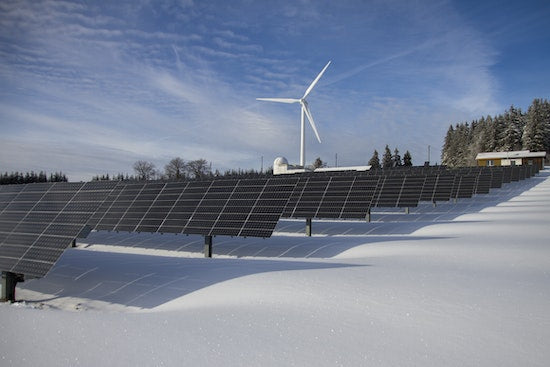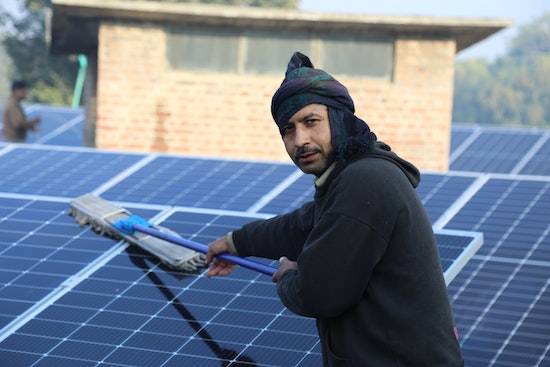
Snow on Solar Panels: Don't Let It Freeze Your Energy Savings
Snow can be a picturesque scene, especially when it blankets the surroundings in a pristine white layer. However, when it comes to solar panels, this wintry wonderland might not be as delightful. Solar panels are designed to harness the sun's energy and convert it into electricity, but snow accumulation can hinder their performance. In this article, we will explore the impact of snow on solar panels, preventive measures to address this issue, and how to maintain solar panel efficiency in winter.

How Snow Affects Solar Panels
You have to bear in mind that specks of snowfall aren't a cause of concern because they do not affect your solar panels significantly. But the accumulation of thick snow due to a snowstorm could cause various issues that could lead to the damaging of the solar panels or making power production less efficient. In this section, we will explore how snow affects solar panels
Reduced Sunlight Exposure
One of the primary ways snow affects solar panels is by obstructing sunlight exposure. When snow accumulates on the surface of solar panels, it creates a physical barrier between the photovoltaic cells and the sun. As a result, the amount of sunlight that can be absorbed and converted into electricity decreases significantly.
Decreased Energy Production
The reduced sunlight exposure directly translates to decreased energy production. Even a thin layer of snow can cause a noticeable drop in the output of solar panels. In regions with heavy snowfall, this impact can be more pronounced, potentially leading to prolonged periods of reduced electricity generation.
Mismatched Output
In larger solar panel arrays, where multiple panels are interconnected, the impact of snow can be even more problematic. When some panels are partially covered with snow while others are not, it leads to mismatched electricity output. This disparity in output can disrupt the overall system performance and efficiency.
Snow Weight and Structural Stress
Snow accumulation on solar panels can add weight to the structure. While solar panels are designed to withstand various environmental conditions, excessive snow load can exert additional stress on the mounting systems and the rooftop. In extreme cases, this added weight can lead to structural damage.

Preventive Measures
To mitigate the impact of snow on solar panels, several preventive measures can be employed:
Tilted Mounting Systems
Solar panels are often installed at an angle to maximize sunlight exposure. This tilted arrangement allows snow to slide off the surface more easily, reducing the chances of snow buildup. Additionally, choosing a steeper tilt can facilitate faster snow shedding.
Heating Elements
Some solar panels come equipped with built-in heating elements. These elements generate enough heat to melt the snow on the surface of the panels, ensuring continuous electricity production even during snowy conditions. While this technology is effective, it may lead to slightly higher energy consumption.
Brushing Off Snow Manually
For solar panels without heating elements, manual snow removal can be an option. However, extreme caution is necessary to avoid damaging the panels during the process. Soft brushes or snow rakes can be used to gently remove the snow, but professional assistance is recommended to prevent any mishaps.
Maintaining Solar Panel Efficiency in Winter

Maintaining solar panel efficiency during winter is essential to ensure maximum energy generation even in colder and less sunny conditions. Here are some tips to help you achieve this:
Regular Monitoring and Cleaning of Solar Panels
Winter weather can bring snow, frost, and dirt buildup on solar panels, reducing their efficiency. It's crucial to monitor the panels regularly and clean them when necessary. Gently remove snow using a soft broom or brush, being careful not to scratch the surface. Cleaning with a mild soap solution and water can also help get rid of dirt and grime. Ensure the panels are dry before turning them back on.
Ensuring Proper Wiring and Connections
Cold temperatures can impact electrical connections, leading to potential power loss or system failure. Check all the wiring and connections for any signs of damage or wear. Ensure they are well-insulated and securely fastened. If you notice any issues, have a professional electrician inspect and repair the connections.
Utilizing Battery Backup Systems for Uninterrupted Power Supply
In winter, days are shorter and there is less sunlight, which can result in lower energy production. By installing a battery backup system, you can store excess energy generated during sunny periods and use it when sunlight is limited. This way, you can maintain a steady power supply even during cloudy days or at night.
Angle Adjustment and Positioning
In many regions, the sun's angle changes during winter. To optimize energy production, consider adjusting the tilt angle of your solar panels to better capture sunlight during the shorter days. Many solar panels are mounted on adjustable racks precisely for this purpose. Additionally, ensure that there are no obstructions like tree branches or buildings casting shadows on the panels.
The Anker 531 Solar Panel stands out as one of the best solar panels for winter due to its 3-mode angle adjustments, allowing seamless optimization of the panel's position to capture maximum sunlight even at low angles during the shorter days. Its IP67 waterproof protection ensures durability in harsh winter weather conditions, safeguarding its functionality. Additionally, the solar panel's impressive 1.5X higher energy conversion efficiency, thanks to monocrystalline solar cells and a sunlight-trapping surface, enables it to generate more energy from limited winter sunlight, making it an efficient and reliable choice for powering devices and charging batteries throughout the colder months.
Clear Surrounding Vegetation
Trim any overhanging branches or vegetation that may block sunlight from reaching the solar panels. This step is especially important in winter when the sun's trajectory is lower in the sky, making it easier for objects to cast shadows on the panels.
Inspect for Any Physical Damage
Winter storms or heavy snow loads can sometimes cause physical damage to solar panels. Inspect the panels visually to ensure there are no cracks or breaks in the glass. If you notice any damage, contact a professional to assess the situation and perform any necessary repairs.
Final Thoughts
While snow on solar panels can pose challenges to energy production, employing preventive measures can help mitigate its impact. By considering tilted mounting, utilizing heating elements, and ensuring regular snow removal, solar panel owners can maintain efficiency and continue to harness clean, renewable energy even during the winter season. With proper care and planning, solar energy systems can weather the snow and contribute to a more sustainable future.
FrequentlyAsked Questions About Snow on Solar Panels
Below are additional concerns homeowners have about the issue of snow on solar panels—
How Does Snow Affect Efficiency?
Snow significantly affects solar panel efficiency by blocking sunlight from reaching the photovoltaic cells on the panel's surface. When snow accumulates on the panels, it acts as a physical barrier, reducing the amount of sunlight absorption and conversion into electricity. This results in decreased energy production and a noticeable drop in panel efficiency. Additionally, snow buildup can cause uneven energy generation in solar panel arrays and may create icy patches when partially melted snow refreezes, further hindering sunlight absorption.
Will the Snow Melt Off My Solar Panels?
The snow will likely melt off your solar panels if the temperature rises above freezing point and there is sufficient sunlight. Solar panels are designed to absorb sunlight and convert it into heat, which can help melt the snow on their surface. Additionally, the dark color of the panels aids in absorbing heat, further facilitating snowmelt. However, in cases of prolonged cold weather or heavy snow accumulation, the snow may take longer to melt, and manual intervention or alternative measures, like tilted mounting or heating elements, may be necessary to expedite the process and restore optimal solar panel efficiency.
Do Solar Panels Work on Ice?
Solar panels can still generate electricity to some extent when covered with a thin layer of ice. The photovoltaic cells in solar panels can convert some sunlight into electricity even when there is ice on the surface. However, the efficiency of the panels will be significantly reduced due to the reduced sunlight absorption caused by the ice. In extreme cases of thick ice coverage, the panels may not be able to produce any electricity at all. It is essential to remove ice from solar panels whenever possible to ensure optimal energy production and efficiency.














